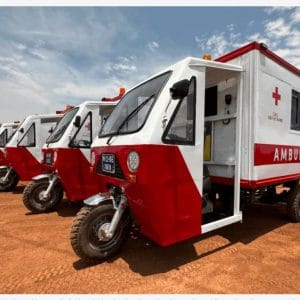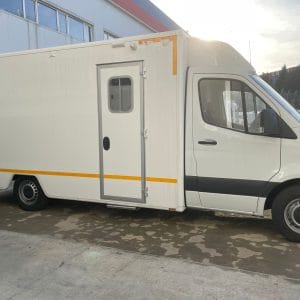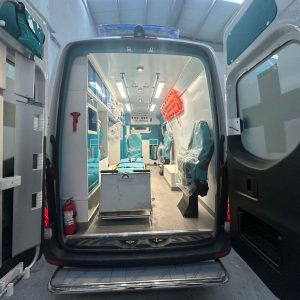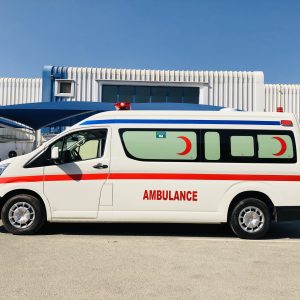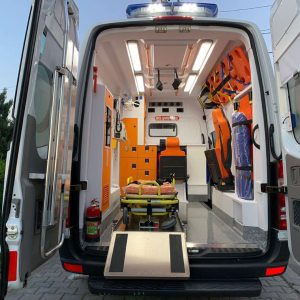Type 3 ambulances are a class of ambulance designed for emergency medical services (EMS). They are built on light-duty van chassis like the Ford Transit or Dodge Ram ProMaster. Compared to larger Type 1 and Type 2 ambulances built on truck or van chassis, Type 3 ambulances offer greater maneuverability and fuel efficiency for basic life support services.
Type 3 ambulances are often used for medical transport and emergency responses in urban settings where their smaller size allows for easier navigation. They also work well for rural EMS when longer transport distances are not required. While they lack the capacity and capabilities of larger ambulance models, Type 3 ambulances provide an important option for providing emergency medical care quickly and affordably.
The Type 3 classification refers to the chassis type under a set of US General Services Administration standards for ambulances. They are the lightest duty and smallest size ambulance under these standards that include specifications for patient compartment size, equipment, and other features. Understanding the unique capabilities and limitations of Type 3 ambulances helps EMS providers select the right vehicles to meet their operational needs.
History
Type 3 ambulances first emerged in the 1970s as a lighter and more maneuverable alternative to the larger Type 1 and Type 2 models. They were well-suited for rural and volunteer emergency medical services (EMS) that needed a more versatile and affordable ambulance.
The Type 3 classification refers to a van-style ambulance built on a cutaway van chassis. This allowed manufacturers to take a commercial van chassis from an automaker like Ford or GM, and outfit it with customized ambulance components for medical transport. Compared to boxier Type 2 models, the Type 3 van format had a lower profile and tighter turning radius ideal for navigating smaller streets and driveways.
In the early days of Type 3 ambulances, they were often built on full-size vans like the Ford Econoline and Chevrolet G-Series. These vans provided ample interior space for attendants and patients, while remaining easy to drive. As full-size vans decreased in popularity in the 1990s and 2000s, manufacturers shifted towards using smaller commercial vans like the Ford Transit, Mercedes Sprinter, and Ram ProMaster as Type 3 platforms.
Today, Type 3 ambulances are found in communities across North America and beyond. They offer EMS providers flexibility in a rapidly evolving industry. While not as spacious as the largest Type 1 trucks, Type 3s can readily meet the needs of most emergency calls. Their success demonstrates the value of right-sized and maneuverable EMS vehicles for the full spectrum of 911 response.
Design and Features
Type 3 ambulances have a typical boxy exterior built on a van or truck chassis. They are smaller in size compared to the larger Type 1 and Type 2 models, making them more maneuverable in tight urban settings.
Some standard design features include:
- Dual rear wheels for stability and weight distribution
- Running boards and grab handles for easy access
- Sliding side door and rear doors for loading patients
- Emergency lights and sirens
- High visibility striping and reflective decals
- Reinforced bumpers and grille guard for protection
The interior is optimized for patient care and transport. There is usually bench seating in the front for the driver and passenger. The rear patient area contains an adjustable stretcher or cot mounted on tracks, oxygen tanks, and cabinets for medical supplies. Most models have climate control systems to maintain interior temperature.
Key interior features:
- Stretcher with straps and anchor points
- Bench seat with seatbelts
- Overhead LED lighting
- Intercom system
- Oxygen outlets and suction units
- Cabinets and drawers for equipment storage
- Medical waste bins
- IV pole and hooks
- Action Area with counter space for EMTs
The compact interior layout allows EMTs to provide medical attention and monitor the patient during transport to the hospital.
Common Chassis
Type 3 ambulances are most commonly built on light-duty van chassis like the Ford E-Series, Chevrolet Express, or Dodge Sprinter. These provide a balance of maneuverability, cargo capacity, and cost-effectiveness.
Some of the most popular chassis used include:
- Ford E-Series: The E-Series van chassis has been a top choice for Type 3 ambulances for decades. It offers a proven and reliable platform with good visibility and maneuverability. The V8 engine provides decent power for the size.
- Chevrolet Express: Similar to the E-Series, the Chevy Express provides a sturdy yet nimble commercial van chassis. It’s available with a range of engine choices including the Vortec V8. The Express handles well fully loaded with medical equipment.
- Dodge Sprinter: The Sprinter brings a more modern, fuel efficient option to the Type 3 ambulance segment. Its diesel engine offers strong torque while maintaining good fuel economy. The Sprinter has a taller, boxier shape which maximizes interior space.
- Mercedes Sprinter: The Sprinter is mechanically similar to the Dodge variant, providing the same diesel power and boxy shape. Some manufacturers opt for the original Mercedes-Benz chassis as an upscale option.
- Ford Transit: As a newer full-size van, the Ford Transit chassis gives ambulance builders another option. It has modern styling and good configuration flexibility. The available EcoBoost V6 provides solid performance.
These mainstream, high-volume van chassis keep acquisition costs reasonable while still delivering the necessary capabilities for Type 3 emergency response. Familiarity and ease of service are also factors when selecting a chassis.
Interior Layout
Type 3 ambulances have a standard interior layout that is optimized for patient care and transport. The exact configuration can vary slightly between manufacturers, but most share some common elements.
The patient care area is located in the rear of the ambulance. It typically contains a stretcher mounted on tracks or rails so it can be slid in and out of the vehicle. The head of the stretcher is positioned next to the side door for easy loading and unloading.
On either side of the stretcher are bench seats for EMTs to sit and monitor the patient. There is storage for medical equipment and supplies within arm’s reach. Oxygen tanks, a defibrillator, BP cuff, and other critical gear is secured for transport.
Overhead the patient area you’ll find adjustable LED lights to illuminate the scene. There are also grab handles on the ceiling for EMTs to stabilize themselves while the vehicle is in motion.
At the front of the patient compartment is a cabinet area for additional storage and an attendant seat facing rearward. This seat allows an EMT to keep an eye on a patient during transport.
Some customizable options for the interior include:
- More bench seating or attendant seats
- Lockable cabinets or drawers
- Infection control surfaces
- Mounts for medical devices
- Video camera systems
- Bariatric upgrades for larger patients
Manufacturers collaborate with EMS providers to optimize the layout based on their specific needs and protocols. But overall, Type 3 interiors achieve an efficient use of space for quality patient care.
Medical Equipment
Type 3 ambulances are equipped with a variety of medical devices and capabilities to provide emergency medical services in the field. Some of the key medical equipment found in these vehicles includes:
- Defibrillator – Used to deliver an electric shock to a patient in cardiac arrest to restore normal heart rhythm. Type 3 ambulances have an automated external defibrillator (AED) on board.
- EKG Monitor – Allows paramedics to view a patient’s heart rhythm and vital signs like blood pressure, respiratory rate, and pulse oximetry. Helpful for identifying cardiac issues.
- Oxygen Delivery System – Includes oxygen tanks, regulators, and tubing to provide supplemental oxygen to patients having breathing difficulties.
- Suction Unit – Used to suction fluids and vomit from a patient’s airway. This helps keep the airway clear.
- IV Equipment – Allows starting IV lines and administering IV fluids or medications. This includes IV catheters, tubing, fluids, and more.
- Stretchers – Ambulances have wheeled stretchers to transport patients. Some have powered lift systems for loading the stretcher into the vehicle.
- Spine Boards – Used to immobilize patients with potential spinal injuries to prevent further damage during transport.
- Splints – For immobilizing fractured bones.
Having these medical tools on board allows paramedics to provide crucial, often life-saving interventions for patients being transported to the hospital. The capabilities allow stabilizing and treating various medical emergencies and traumatic injuries in the pre-hospital setting.
Safety
Type 3 ambulances have rigorous safety standards to protect patients and emergency medical personnel. They are required to pass testing by organizations like the National Highway Traffic Safety Administration (NHTSA) and the Commission on Accreditation of Ambulance Services (CAAS).
Some key safety features include:
- Crash Testing: Ambulances must meet crashworthiness standards, undergoing tests that simulate frontal, side and rollover crashes. They are tested with crash test dummies secured on cots and seats.
- Equipment Mounting: Medical devices and cabinets must be securely mounted to withstand crashes and sudden stops/starts.
- Patient Compartment: The patient area has padded surfaces and secured equipment to prevent injury. There are also grab rails for stability.
- Driver Compartment: The driver area is reinforced to maintain integrity in a crash to protect the driver.
- Lighting/Reflectors: Type 3 ambulances have emergency lighting systems, reflective striping, and back-up alarms for visibility and safety.
- Electrical System: The electrical system is designed to minimize fire hazards with features like fusing and circuit protection.
By meeting rigorous government crash test standards and CAAS accreditation, Type 3 ambulances provide a high level of safety for patients and EMTs during transport. Proper design and manufacturing is critical.
Cost
Type 3 ambulances can range greatly in price depending on the chassis, features, medical equipment, and customization. Prices typically start around $120,000 and can go over $200,000 for a fully equipped unit. Some of the main factors affecting the cost of a Type 3 ambulance include:
- Chassis – A new chassis from an OEM like Ford or Chevrolet can cost $40,000-$60,000. Type 3 ambulances are often built on light-duty van chassis to keep costs down versus larger modular chassis.
- Medical Equipment – Advanced medical devices, monitors, stretchers, cabinets, and more add a significant cost. A high-end cardiac monitor may cost over $30,000 alone. Basic vs advanced life support capabilities differ in equipment needs.
- Custom Interior/Exterior – Custom layouts, cabinetry, lighting, paint, decals, and branding all add to the final price. Ambulance manufacturers offer different options to suit budget and needs.
- Safety Features – Additional safety requirements like rollover protection, backup cameras, lane departure warning bring added expenses. Regulatory compliance also plays a role.
- Warranties & Support – Extended warranties and maintenance plans available from manufacturers can add thousands to the total cost over the lifetime of the vehicle.
Keeping specifications simpler helps reduce the overall price. But medical capabilities, customization, and robustness come at a premium. Careful planning of features and equipment is needed to balance costs versus needs for Type 3 ambulances.
Major Manufacturers
Several large companies design and manufacture Type 3 ambulances in the United States and globally. Some of the leading manufacturers include:
- Horton – Part of REV Group, Horton is one of the largest ambulance manufacturers in North America. They offer a range of Type 3 models on chassis from Ford, RAM, and Chevrolet. Horton ambulances feature multiple floorplans and can be customized for different applications.
- Braun – Also part of REV Group, Braun has manufactured ambulances since 1914. They are known for their durability and offer Type 3 models on Ford and Dodge chassis. Braun incorporates feedback from EMS professionals into their ambulance designs.
- Road Rescue – Road Rescue engineers Type 3 ambulances with a focus on ergonomics, safety, and durability. They build on chassis from Ford, RAM, and Chevrolet. Road Rescue is part of Allied Specialty Vehicles.
- Wheeled Coach – A major ambulance manufacturer based in Florida, Wheeled Coach builds Type 3 models on chassis from Ford and Chevrolet. They emphasize quality materials and construction methods.
- Marque – A subsidiary of JJEMS, Marque ambulances are built with a modular design to allow customization. They offer Type 3 models on the Ford Transit chassis. Marque focuses on reliability and ease of maintenance.
- Osage Ambulances – Located in Missouri, Osage has specialized in ambulance manufacturing since 1969. They engineer Type 3 models on the Ford Transit chassis with a focus on functionality and safety.
The Future
The future of Type 3 ambulance manufacturing will likely see several key trends and innovations.
New Materials
Manufacturers are exploring new lightweight composite materials to reduce vehicle weight and improve fuel efficiency without compromising safety or durability. Carbon fiber materials are being tested and implemented in some newer models.
Advanced Telemedicine
More advanced telemedicine capabilities will likely be integrated into ambulances. This may include high-resolution cameras and monitors to allow remote medical experts to evaluate and communicate with patients in real-time during transport. Advanced vital sign monitoring with automated alerts is also expected.
Autonomous Driving
While fully autonomous ambulances are likely still years away, certain autonomous driving features may emerge to assist EMTs and paramedics. This could include automated braking, lane centering, and adaptive cruise control – especially for long distance rural transports on highways.
Electric Ambulances
As electric vehicle technology improves, zero-emission electric ambulances will become more viable and affordable. These can reduce noise and air pollution in urban areas. Charging infrastructure and range limitations remain challenges to be solved.
Drone Integration
Ambulance drones capable of rapid medical supply transport and airlifting patients in emergency situations may be integrated with ground units. This can provide access to patients in remote areas quickly. Regulations will need to be developed to integrate them safely into the airspace.
In summary, ambulances of the future will leverage new materials, telemedicine, automation, electrification, and drones to improve medical care and transportation efficiency. However, rigorous safety testing and design will remain paramount.



